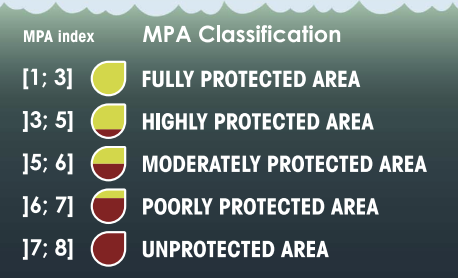Marine Protected Areas (MPAs) are areas within oceans or lakes that are protected by restricting certain activities. “They are a global conservation and management tool to enhance the resilience of linked social-ecological systems with the aim of conserving biodiversity and providing ecosystem services for sustainable use.” (Horta e Costa et al. 2016)
Initially, the International Union for Conservation of Nature categorized MPAs based on their objectives, nonetheless, discrepancies may occur regarding regulation generating uncertainty at the point of evaluating the effectivity of MPAs. Consequently, a novel global classification system, including regulation as an alternative or complement is presented below (Horta e Costa et al. 2016). Scores for the uses depending on their impact on marine biodiversity were integrated into an index.
The proposed system classifies MPAs and their individual zones particularly, thus globally applicable unambiguously discriminating the impact of users (Horta e Costa et al. 2016):


 Graph from http://www.classifympas.org/ from the Scholarity article: Horta e Costa, Bárbara; Claudet, Joachim; Franco, Gustavi; Erzim, Karim; Caro, Anthony; Gonçalez, Emmanuel J: A regulation-based classification system for Marine Protected Areas (MPAs) 2016.
Graph from http://www.classifympas.org/ from the Scholarity article: Horta e Costa, Bárbara; Claudet, Joachim; Franco, Gustavi; Erzim, Karim; Caro, Anthony; Gonçalez, Emmanuel J: A regulation-based classification system for Marine Protected Areas (MPAs) 2016.
Conclusion:
“The best next thing to having a robust dataset on MPA effectiveness at the biological and socio-economic dimensions (which is currently lacking and challenging to obtain), is to assess managers’ and policy-makers’ goals when designing, classifying and implementing MPAs. This can be achieved through a system that integrates different levels of potential impact of uses allowed inside these areas, based on the regulations of those uses. This system can be used as an alternative or in combination with the current IUCN categories. The classification system proposed here is based on classes that represent an increasing gradient of impacts of uses resulting in a simple and realistic classification, less prone to errors in the assignment of those classes. This is supported by an easy-to-follow decision tree, which allows unambiguous classification of zones and MPAs. This is a robust, simple and globally applicable system to be applied by scientists, managers, spatial planners and policymakers when designing new MPAs, assessing existing ones and comparing outcomes at a global scale” (Horta e Costa et al. 2016).
Article source: https://www.classifympas.org/uploads/files/A_regulation-based_classification_system_for_Marine_Protected_Areas-MPAs.pdf

